Show me my Country – Part 3
01/10/17 10:58:pmWild baboons greet us in the Simien Mountains, and we visit the legendary castles of Gondar on the second day of our Ethiopian holiday.
Friday 13 April 2017
We wake early at the AG Gondar hotel and head for the restaurant. This is a very upmarket establishment. My friends and I stand in the doorway of the hotel restaurant and look around like Ethiopian black-maned lions emerging from the forest. We move tentatively towards some empty tables. A tall, uniformed waiter glides towards us balancing a glinting tray of cups and saucers on one raised hand. We show our room keys, and he smiles broadly, gesturing to a circular, glass-topped table. The guys approach the table, taking it all in. Omer pulls out a chair for his Dad. Mohay lowers himself onto a bronze metal framed chair with plush fabric upholstery. He runs an index finger carefully along the edge of the glass.
“That looks dangerous. Someone might cut themselves on that,” Mohay murmurs to himself. Hussain stares at the small bouquet of colourful flowers in a glass vase at the centre of the gleaming table.
“Are they real? They look real!”
He tenderly touches the petals.
“They’re real! That’s incredible. They must have so much water around here they can cut fresh flowers every day. Nobody grows flowers in Degan. We wouldn’t waste the water.”
Fresh bread rolls, omelettes, coffee, honey and jam soon fill the table. We cheer when Hussain butters his bread before loading the huge dollops of strawberry jam that threaten to pour onto his wrist.
“See, I’m learning to eat like a foreigner!”
“Like a tourist!”
Laughter.
His quip is somewhat ironic, to say the least. Ethiopian cuisine is arguably the most delicious traditional food in Africa, (see my blog on this). There are strict rules governing dining etiquette. Wash your hands before and after eating; a junior member of the household comes around with a jug of warm water, soap, a basin and a towel. A steady stream of water is poured so the diner can soap up and rinse hands while remaining seated. Always eat with your right hand and never put your fingers in your mouth to avoid saliva contamination. Tear bite-sized pieces of injera only from your side of the platter.
After breakfast, Belete meets us in the foyer right on time. He is our local guide, and we discuss options for the day. The guys want to see some of the sites popular with Ethiopian tour groups like the Simien mountain views around here and the famous Fasil Gebbi. If we have time, we will visit the intriguing Fasil’s Bath and leave town in the afternoon to reach our accommodation at the inspiring Awra Amba community. It’s going to be a full day.
We drive about 40 km north from Gondar. The road follows a series of valleys and then starts to rise from Gondar’s 2,130 m altitude. At 2,300 m we reach the Kossoye Lookout. The bright morning light means we are here before the haze sets in. The views looking north into the Simien mountains are impressive. From where we stand, a steep ravine falls almost vertically about 200 m. This late in the dry season, the slopes are the colour of straw dotted with bright green shrubs and occasional copses of small trees. Perhaps there has been some early rain heralding the rainy season.
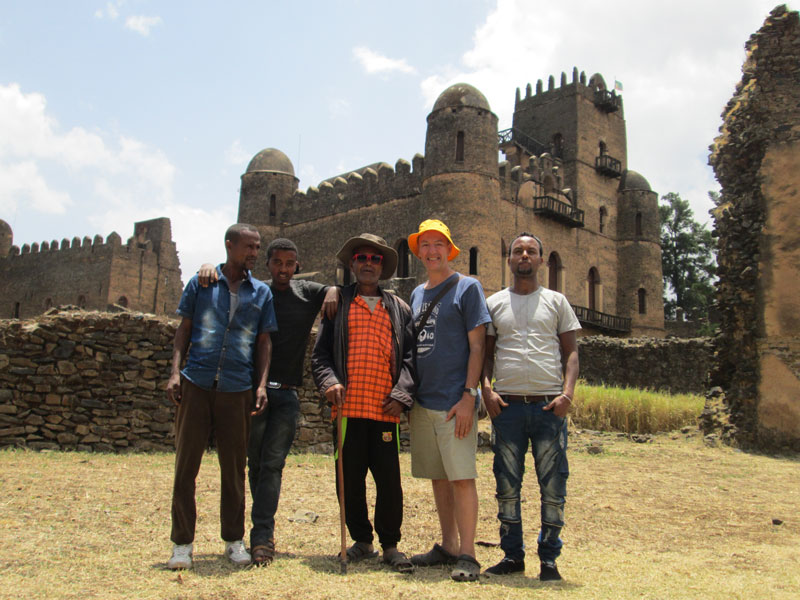
Our travel group: Hussain, Awel, Mohay, Sam and Omer.
We leave our vehicle and set out on foot along a stony path to get a closer view from near the edge of the ravine. Mohay shuffles rapidly, swinging his walking cane.
As we near the edge, a startled troop of a dozen baboons scamper straight up a cliff to our left and sit in a silhouetted row along the ridgeline above us. We stop, stunned speechless by the panoramic view that greets us. We look like a line of meerkats scanning the distance. For a moment all we can hear is the wind. Then we start looking at each other. Belete smiles. He says he loves bringing people here for this magic moment. I understand why. I pull out my binoculars which pass from hand to hand.
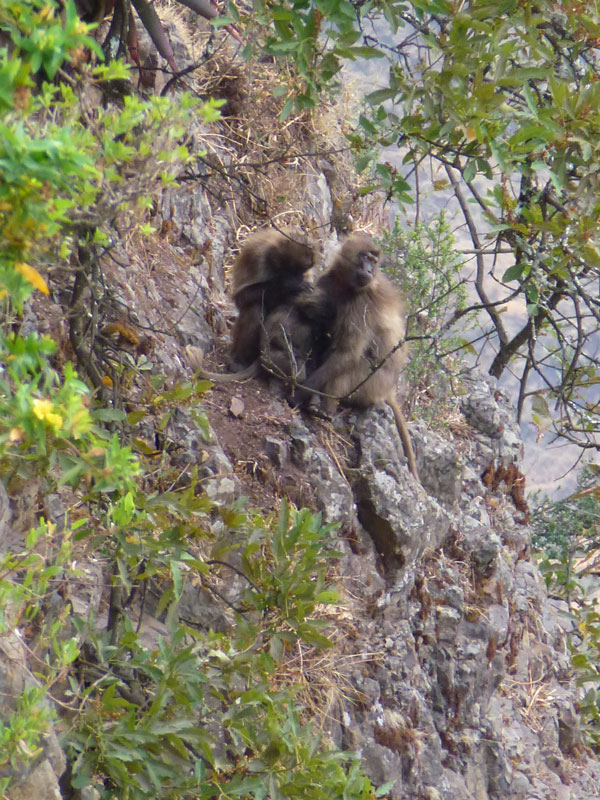
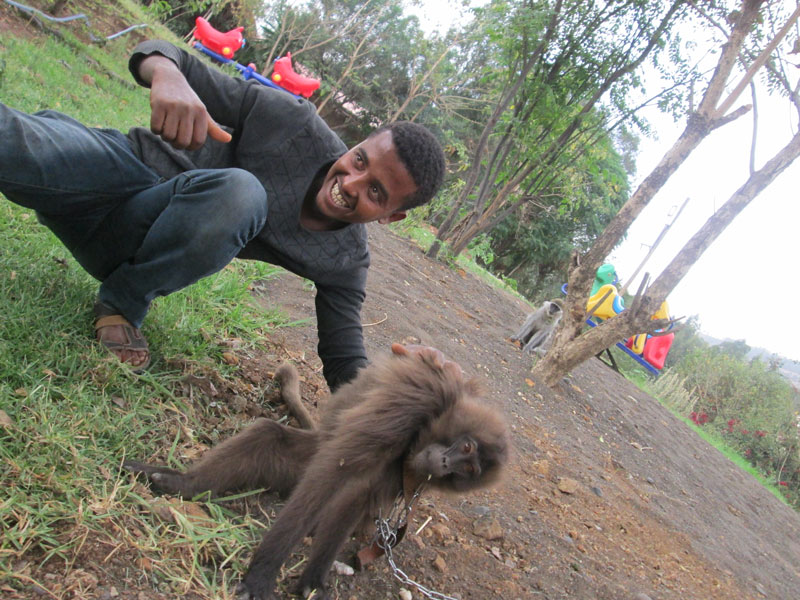
Cliff dwelling Gelada baboons. Awel grooms his new best friend.
Eighty percent of Africa that lies above 3,000 m is in Ethiopia. My degree in Geology was inspired by my childhood fascination with these towering peaks and steep-sided, river-cut valleys. Razor sharp ridge lines and eroded pinnacles are flanked by precipices that plunge down to winding rivers still cutting inexorably into the hard basalt rock. About 120 km north from here, Ethiopia’s highest peak, Ras Dejen, or Dashen, rises to 4,550 m.
Belete plays the role of geology field trip tutor well. He tells us of the colossal forces that created what we see. Put simply, the Simien mountains were uplifted by a massive swelling under the earth’s crust about 75 million years ago. Finally, the upward pressure became so great that a vast outpouring of lava burst forth about 40 to 25 million years ago. This fluid lava flowed out and spread over a wide area similar to a Hawaiian shield type volcano. The result is a 3 km thick sequence of lava layers. All this geological activity pre-dates the opening of the Rift Valley. The Drakensberg mountains of South Africa were formed similarly.
Ethiopian wildlife in these mountains includes the endemic Walia Ibex mountain goat and troops of Gelada baboons who live on the sheer cliffs. Conservation International lists the Simiens as an eastern Afromontane biodiversity hotspot. Ecosystems vary with altitude and remoteness. The result is a high level of endemism with over 1,200 plant species. There are many raptors in these mountains. A famous example is the Lammergeier, also known as the Bearded Vulture. They soar on their wingspans of up to 2.8 m. These vultures live almost exclusively on the bone marrow they glean from the fragments of the bones they smash by dropping them onto the rocks below. Of the 180 bird species in the Simiens, 19 are endemic to Ethiopia and neighbouring Eritrea. The endemic Ethiopian wolf is one of the rarest canids in the world and Africa’s most endangered carnivore. We don’t see any Walia Ibex or Ethiopian wolves today, but the baboons are a fun diversion. We walk in their direction.
The Simien Mountains National Park is about a half days drive north from here. I’m only sorry that we don’t have time on this trip to go that far.
Travellers with my Ethiopian Adventure Tours groups drive through the heart of these ranges. On day 1, we fly 1000 km north from Addis to Axum where we rendezvous with our vehicle and driver. After adventuring around the truly ancient sites of early Ethiopian civilisation at Yeha and Axum, we wend our way south through the Simien Mountains and explore the Simien Mountains National Park near Debark town. Then we carry on south to Kossoye and Gondar.
Omer and Hussain photograph everything. They decide to get closer to the baboons. Spooked, the baboons seem to jump off the cliff to certain death. They grab onto jutting rocks and appear to run diagonally down and across the cliff face. Loosened rocks scatter down to the bushy depths. I wonder how often they plunge to their deaths. Not often I suspect. Hussain comments they are moving so fast it is impossible to get a zoom photo of the grey-brown baboons against the grey-brown of the cliff face.
We follow the path around the headland and about 100 m straight down below us we can see cattle herders minding their grazing livestock on a tiny ledge that is far from horizontal. I wonder if they ever get showered by rocks dislodged by scampering baboons. A further 100 m below them a braided river meanders through the valley floor.
The local authority has built a small reception centre offering a roofed seating area to take in the view. There is a sloping field of tufty grass for self-sufficient campers, but facilities are still limited.
“Who would want to sleep in a tent up here,” muses Omer.
“Maybe to be right here for the sunset and sunrise,” I offer.
“I bet it rains a lot. It is quite windy. Give me a warm tukul house in Degan any night.”
He shivers in the wind. He is a lowland man. Kossoye, at 2,300 m altitude is much cooler than Degan at 1,515 m. It is much wetter too. Every year, Degan farmers pray for rain. Sometimes their prayers are answered.
We chat with some locals on the path back to our vehicle. Mohay’s salt and pepper hair endows him with social seniority. In Ethiopian culture, older folks are always treated with great respect. Amharic grammar has a formal tense, for addressing a person of senior social status. When shaking hands with a person of higher social standing, I have learned to touch my right elbow with the fingertips of my left hand as a sign of respect.
Mohay is clearly enjoying sharing his wonder and amazement. He stops to talk to a stooped man briskly herding sheep along the path. The two old farmers have an animated discussion while we stand in a small circle around them listening and learning. I see Mohay happy. He is in his element. I am thrilled for my old friend. He has been through some tough times overcoming his stroke and just keeping his family fed.
It is mid-morning when we arrive back in Gondar. The sun is bright in the cyan sky. The cooling rains are on their way, but it is still a pleasant 26 C. Annual temperatures in Gondar range from the low twenties around July to the low thirties in January. We decide to press on and not stop for coffee.
Belete directs Omer through the crowded streets into the Piazza and past the roundabout with the statue of Emperor Tewedros II (1818 – 1868). Tewedros defeated all his rivals in battle then took the throne in 1855. He embarked on a major program of modernisation and reform. This warrior king is considered the founder of modern Ethiopia. He briefly united the squabbling princes ending a turbulent century known as Zemene Mesafint or, Era of the Princes. In Gondar, he stands erect with a long sword in one hand, and a double tipped spear and round shield in the other. He shimmers in a coat of gold paint.
Facing Piazza is the art deco central post office building dating from the brief era of Italian occupation (1935 – 1941). Under Mussolini, the Italian invaders were very industrious builders. In less than a decade their alpine engineers built an impressive network of roads through the mountains and left many notable buildings that still stand. Of course, enslaving the local population as forced labourers was a major factor in this ‘achievement’.
The castle turrets of Fasil’s Gebbi stand silent guard over Gondar’s Piazza. These stone towers with domed tops standing in the heart of a contemporary African city centre are a memorable sight.
We alight from our minibus outside the main gate and enter the Fasil Gebbi grounds with Belete in the lead. He directs us to the ticket office. An Ethiopian lady behind the ticket window looks at our group. With her eyes on me, she says,”You are 200 Birr but your friends are 30 Birr each.”
My friends looked at each other then at me. Very politely, Mohay comes up to the window and speaks for me.
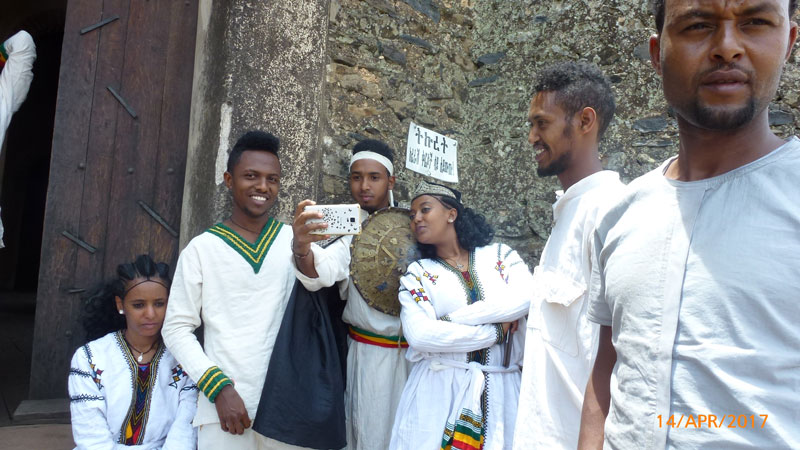
Spirits with smartphones.
“My friend Sam is Ethiopian too, and we think he should only pay 30 Birr. He has lived here for many years. Hey, Sam, say something. Prove it to the lady.”
I jabber something in Amharic about what an interesting place Gondar is and that I’m showing my friends of many years around the region where they have never been.
The pixie dust of astonishment has the hoped-for effect.
“Well, I’ve never heard a Ferenge speak Amharic so well. I see what you mean. OK then. It’s 30 Birr for each of you.”
Our smiles and thanks affect the lady who breaks out into a broad grin. She shakes her ringleted head from side to side and stamps our tickets with five loud thuds.
We gather under a tree with a good view of the castles as Belete briefly introduces each castle. This was Ethiopia’s capital for about 200 years from the mid 17th century. For centuries the Ethiopian royal court was a mobile encampment that required a ruler to continuously travel throughout their lands. Emperor Fasilides (1603 – 1667), ended this tradition and set up a fortified Imperial residence in Gondar in 1636. A succession of orthodox Christian emperors followed suit within this 12 gated, walled enclosure. This is why Fasil’s Compound or Fasil Gebbi, is known as the Camelot of Africa. It was also the centre of Jewish life in old Ethiopia. Gondar is another Unesco World Heritage site.
It’s on visits like this that one really appreciates a good local guide like Belete. He was born and raised in Gondar and has studied Ethiopian history at university. He knows many fascinating stories about the various emperors who called this place home.
Ever the practical farmer, Mohay gazes at the castles undergoing Unesco sponsored restoration.
“I’m glad they are fixing this place up. It does look a bit shabby. It just needs a fresh coat of paint and some new plaster. I’m sure the tourists would come then. A cafeteria could go in that building, and a lounge or rest area would be great in there by the trees.”
The two brothers-in-law Hussain and Omer are snapping photos with Awel the owner of our rented minibus. As luck would have it, we find ourselves in the middle of a film set. Extras in period costume gather in small groups between shots taking selfies and posing with their swords and shields. Gathered at the top of a grand stone staircase that leads up to a beautiful door of carved wooden panels, are a group of young extras. I’d never seen this before. It was as if the castle grounds were full of ghosts from centuries past. These were spirits with smartphones though.
At first, my friends just take photos. Then Awel, the confident businessman owner of our vehicle, asks if he can borrow a sword and shield to pose for a photo. I am soon helping Mohay hold a shield in his stroke-weakened left hand and a sword in his right. He is resplendent in his bright orange shirt and floppy hat. His stubbly cheeks frame a goofy grin. I don’t think Emperor Tewedros would have approved. Mohay’s outfit doesn’t really rate alongside Tewedros's shining gold, but he still looks priceless.
For two centuries, each Emperor left his mark on the enclosure. One built a steam sauna, others built a lion cage, a library, banqueting hall, royal stable and innovative rainwater gathering and storage system. Another very devout Emperor instituted Ethiopia’s first laws against animal cruelty. He forbade the carrying of live chickens upside down, but this became commonplace again after he abdicated to spend the rest of his years in a monastery. One castle was built by Empress Mentawab (1706 – 1773) whom history remembers as an education pioneer.
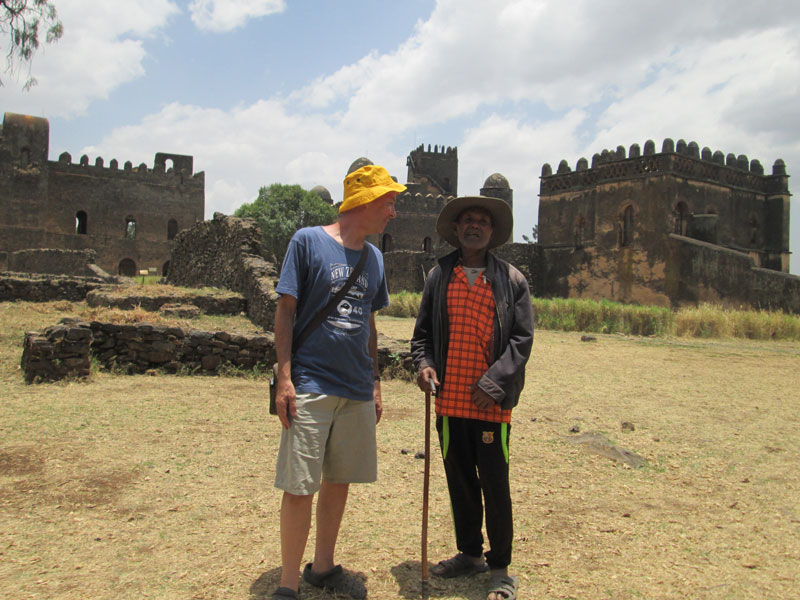
Sam and Mohay discuss the Do - Up potential of the old castle.
As we leave the castle enclosure, Belete asks if we are ready for lunch or if we want to press on to Fasil’s Bath before eating.
“Let’s press on. This is really interesting,” says Hussain summing up the consensus.
We decide on a quick visit to the curiously named Fasil’s Bath. Like Fasil’s Gebbi, it is also enclosed within a fortified wall reinforced by domed towers at intervals.
It looks more like an outdoor Olympic swimming pool with a small castle built in the middle of it. Old Banyan trees with root systems like giant melting candles have grown over the surrounding stone wall. Emperor Fasilides came to power at a time in Ethiopian history when many nobles and peasants resented the increasing influence of the Jesuit priest missionaries who wanted to see the Ethiopian Orthodox Church come under the control of the Vatican. Fasilides’s father Emperor Susenyos I converted to Catholicism and made it the state religion in 1622. Within ten years this fomented a widespread rebellion which forced Susenyos’s abdication.
One of Fasilides’s first acts on coming to power in 1632 was to restore the old religion. He subsequently banished the Jesuits. Some say the so-called bath was for mass baptisms to restore the faithful to the Orthodox Church. Others say it was for the Orthodox Church celebration of Epiphany, or Timket. Timket means baptism. What is certain now is that each year on 19 January, the baptism of Jesus in the river Jordan is celebrated here by thousands of devout Orthodox Christians. Over a period of two weeks prior, a conduit is opened to divert water from the Qaha river down an underground channel to fill the pool. After fasting and praying all night, there is a high point in the Timket day festival when a priest blesses the waters turning them into Holy Water. Hundreds of people then jump in and symbolically renew their baptismal vows. The small castle in the centre of the water is so the royal family could participate without mixing with the commoners.
At this time of year hotel prices in Gondar triple as thousands of Ethiopian pilgrims and tourists flood into town.
Mohay leans against a Banyan tree and declares that he plans to dig a big hole in Degan and hope for a decent rainy season to fill it with rainwater. Then he will charge everyone cash for swimming in it.
It is well after noon, and we are all hungry. We head for the Kassahun Lodge.
Kassahun Lodge is more than a restaurant or hotel. Weddings and large celebrations are held here. Inside, there is a performance stage surround by tables for evening shows. The landscaped grounds feature neat hedgerows, flower beds, a water fountain and tidy lawns. The entrance gate is built as two castle towers with a tessellated castle wall across the top. The whole place is a statement. Today it is quiet. A group of about 15 French sounding tourists arrive at their booked table. There are no other diners.
We find a spot on the verandah and all order a selection of six colourful vegetarian dishes known as Beyainetu. A ten-minute downpour cools the air. After lunch and coffee, Awel and Omer go for an exploration of the grounds. They find a rather pathetic, small baboon chained to a post. Awel is bravest. Awel leans back, ready to recoil and extends his arm toward the unfortunate beast. The baboon seems non-plussed. Awel inches closer and closer. When his hand touches the baboon, the furry creature turns and humps its back towards Awel. Awel relaxes, adjusts his feet and inches closer. His new friend wants to be groomed! Packs of baboons will spend endless hours grooming each other’s fur to remove fleas and dirt.
This poor fellow probably hasn’t had a good groom for years! Awel is his man. Awel grows in confidence and gets even closer.
Omer is snapping photos like mad and calls out, “Up a bit. Left a bit. Aah, Perfect. Yes, right there. Harder.”
Mr baboon is soaking it all up.
We all crack up when the baboon turns and lifts his right arm inviting Awel to scratch under his armpit. Awel draws the line there. He can hardly scratch for laughing anyway. A wild monkey observes from a nearby tree. I wonder what he’s thinking. Would he trade his freedom for an occasional scratch? I doubt it.
We glance at our watches as Belete reminds us we still have a two-hour drive to Awra Amba where we will sleep tonight. We make tracks and head out of Gondar. Then the rain starts again and pours heavily for 30 minutes. A torrent of cocoa coloured water pours down the main street. The footpaths empty and a group of sheep is corralled in a side alley while their shepherd takes shelter under the awning of a mobile phone shop. Mohay stares out the window of the minibus. I know what he’s thinking. Degan won’t have rain for another 2 – 3 months.
We drop Belete off at a junction. He calls out to some passing teenage lads carrying the ubiquitous yellow plastic water containers.
“If these guys give you a lift down the road to the water taps will you show them the turn off towards Bahir Dar?”
Surprised at their good luck on this wet day, six teenage lads eagerly jump in. I ask them how far they have to go for water when there is much outside in the street today. They don’t answer. Instead, they glance at each other then at my friends as if they are hoping for some explanation. It doesn’t come, and they burst into uncontrollable giggles. Their hands cover their sheepish faces, and they cannot look at me. Their unsuccessfully suppressed laughter is infectious. Then it dawns on me. I’ve done it again. It’s that brain freeze. Their eyes tell them something about how I look but this clashes with what their ears tell them. Soon we are all in fits of laughter. We all know what it is, but no one names the cause of our amusement. Soon we reach the turn-off, the boys hop out and thank us for the lift. We met and parted as smiling, laughing strangers.
It doesn’t rain again on our 120 km drive south from Gondar to Awra Amba.
We arrive just on dark at 6:30 to a warm welcome from my friend Turusew. She is carrying her four-month-old son Huletu on her back caressed in a shawl slung over the front of her shoulders.
This is a special place to me. The accommodation is not up to standard for my Ethiopian Adventure Tours clients, but it is always worth a visit and a guided look around if there is time.
We order a quick meal of shiro. Nobody is really hungry after our big lunch. I take a hot shower just in time before a power cut that lasts for two hours. I try to read by candlelight, but it just strains my eyes. I surrender to sleep.
To be continued...
– Article by Sam Cunningham
Recent Posts
Show me my Country – Part 3
Oct 1, 2017, 10:58 PM
Wild baboons greet us in the Simien Mountains, and we visit the legendary castles of Gondar on the…
Show me my Country – Part 2
Aug 22, 2017, 11:56 AM
Day one of our big Ethiopian Adventure brings back memories and reaches new heights.
Show me my Country of Ethiopia – Part 1
Aug 8, 2017, 11:56 AM
Five men celebrate a lifetime of friendship on a road trip in northern Ethiopia.
We Fly With Ethiopian Airlines
Jan 15, 2017, 12:59 PM
One of my most striking memories, as a young boy in the early 1970s, was the flight home from…
Ethiopian Genna – a different kind of Christmas
Jan 15, 2017, 11:05 AM
The Ethiopian Orthodox Church Christmas religious holiday is called Genna. The birth of Jesus Christ…
Ethiopia's Funky Flamingos
Dec 9, 2016, 1:39 PM
"I had never seen such a large body of water before and I can still see the huge waves of airborne…
Why is Ethiopia considered the "Roof of Africa?"
Dec 1, 2016, 2:27 PM
As a boy, I remember being fascinated and enthralled by these mysterious mountains.
Ethiopia Has the Finest Indigenous Cuisine in Africa
Oct 17, 2016, 10:24 AM
Let me tell you about the amazing cuisines of Ethiopia
Even Time is Different in Ethiopia
Oct 12, 2016, 11:56 AM
Where did the time go? Ethiopia is still in the 20th Century!
